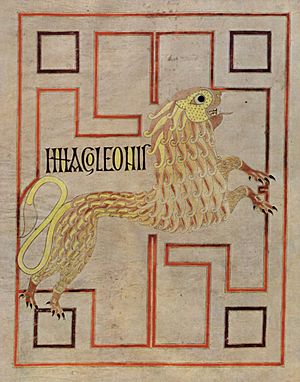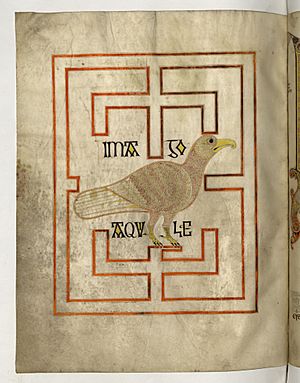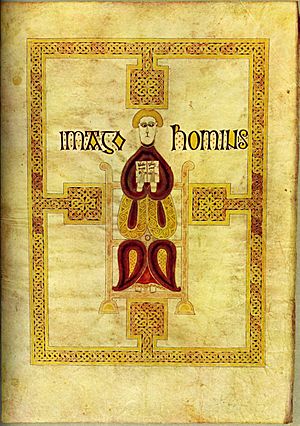Echternach Gospels facts for kids

The Echternach Gospels are a very old and special book made around the year 690 AD. It was probably created at Lindisfarne Abbey in Northumbria, which is in modern-day England. This area was famous for making beautiful handwritten books, like the Durham Gospels and the Lindisfarne Gospels. Many people believe that the same person who wrote the Durham Gospels also wrote the Echternach Gospels. Today, you can find the Echternach Gospels in Paris, France, at the Bibliothèque Nationale.
These kinds of books, called Hiberno-Saxon codices, were very important teaching tools in the Early Middle Ages. They helped spread Christianity. The Echternach Gospels were likely taken by Willibrord, a missionary from Northumbria, to his new Abbey of Echternach. This abbey is now in Luxembourg, and the book is named after it. It was a big deal that this early book came to Echternach. With Willibrord as its leader, the abbey became a very important place for making more books in the Hiberno-Saxon style across Europe.
Contents
How the Book Was Made
Old books like the Echternach Gospels were made in monasteries by people called scribes and artists. These books were not printed like books today. They were written and drawn by hand.
Materials and Process
The books were made from parchment or vellum. This is a special type of animal skin, usually calfskin, that was stretched and prepared. Monks would cut the parchment into pages. First, a scribe would carefully copy the words of the text. Then, an artist would "illuminate" or paint pictures and decorations onto the pages. After all the art was finished, the pages, called folios, were put together and bound into a book. Often, many scribes and artists worked on one book. The main artist for the Echternach Gospels is thought to be the same person who worked on the Durham Gospels. This makes sense because their art styles are very similar, and the books were made around the same time.
Art Style
The art in the Echternach and Durham Gospels is part of the Hiberno-Saxon style. This style was popular in early medieval Britain. You can spot it by its detailed patterns, like woven lines or knots. The pictures often look flat and use geometric shapes. For example, the Echternach Gospels have pictures of the symbols of the Evangelists (like an eagle or a lion) before each part of the book. These figures look very flat and are surrounded by geometric designs.
The idea of drawing a portrait of each author came from older Roman art. As Christianity spread, Roman art styles became popular again. However, the Hiberno-Saxon artists had their own way of drawing. They liked abstract, stylized figures rather than realistic ones. So, the flat, unique figures in the Echternach Gospels show how Roman ideas mixed with the local art style.
Why This Book Was Important
The Echternach Gospels were likely brought by Willibrord when he started the Abbey of Echternach in 698 AD. Willibrord, like many missionaries, traveled through Europe. He used books like this to teach people about Christianity.
Teaching and Liturgy
The Echternach Gospels are an example of an illuminated manuscript that was used for teaching. It was also a liturgical book, meaning it was used in church services. Some people believe that the bright colors and abstract designs of Hiberno-Saxon books helped non-Christians understand the mystery of Christianity. Many people back then could not read. So, the pictures were very important for them to understand what was being taught.
Bede, a monk from the 700s, wrote that religious pictures helped everyone, even those who couldn't read. They could "contemplate... the ever-gracious countenance of Christ and his saints." The beautiful decorations in the book showed people the glory of what was called the "Word of God."
Missionary Work
These books were very important for missionary work in the Middle Ages. For example, in the 500s, Columbanus started many monasteries in Europe. He focused on making books. Also, Augustine was sent by Pope Gregory the Great to England in 597. He brought many manuscripts with him to help convert King Æthelberht of Kent and his people. These Roman books influenced later books like the Echternach Gospels.
Historical Background
The Synod of Whitby was an important meeting for the Church. It happened at Wearmouth-Jarrow in 664 AD. This meeting affected how books like the Echternach Gospels were made.
Church Decisions
The main reason for the meeting was to settle arguments. One big disagreement was about the correct date for Easter. King Oswy made the final decision. He chose to follow the Roman way of Christianity. Even though this decision went against some local traditions, the Hiberno-Saxon art style in books remained popular across Europe.
Mixing Styles
Because of this decision, Roman and local styles started to mix in books. You can see this in the Echternach Gospels. They have Roman-style author portraits but also local "carpet pages" (pages covered entirely in patterns). The writing itself also began to mix Roman capital letters with Germanic runic-style script. These books show how different cultures and styles came together in the early medieval Christian Church.
Later History
The Echternach Gospels were moved from the abbey in 1802. This happened after the French Revolution, when many church properties were taken over by the government.



